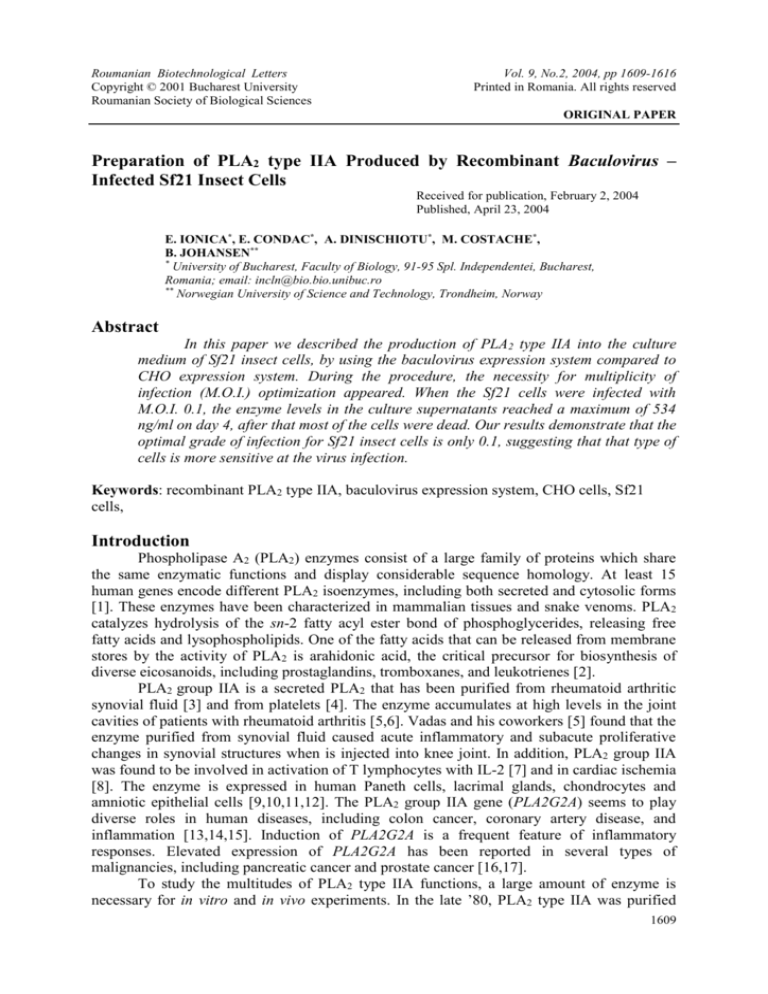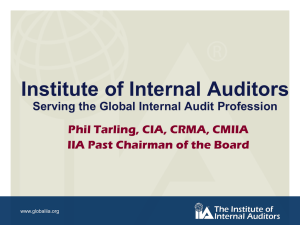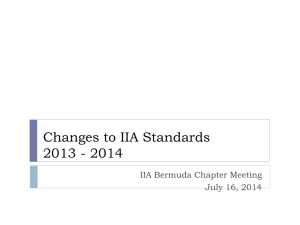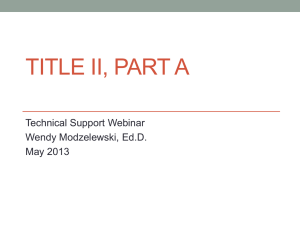
Roumanian Biotechnological Letters
Copyright © 2001 Bucharest University
Roumanian Society of Biological Sciences
Vol. 9, No.2, 2004, pp 1609-1616
Printed in Romania. All rights reserved
ORIGINAL PAPER
Preparation of PLA2 type IIA Produced by Recombinant Baculovirus –
Infected Sf21 Insect Cells
Received for publication, February 2, 2004
Published, April 23, 2004
E. IONICA*, E. CONDAC*, A. DINISCHIOTU*, M. COSTACHE*,
B. JOHANSEN**
*
University of Bucharest, Faculty of Biology, 91-95 Spl. Independentei, Bucharest,
Romania; email: incln@bio.bio.unibuc.ro
**
Norwegian University of Science and Technology, Trondheim, Norway
Abstract
In this paper we described the production of PLA2 type IIA into the culture
medium of Sf21 insect cells, by using the baculovirus expression system compared to
CHO expression system. During the procedure, the necessity for multiplicity of
infection (M.O.I.) optimization appeared. When the Sf21 cells were infected with
M.O.I. 0.1, the enzyme levels in the culture supernatants reached a maximum of 534
ng/ml on day 4, after that most of the cells were dead. Our results demonstrate that the
optimal grade of infection for Sf21 insect cells is only 0.1, suggesting that that type of
cells is more sensitive at the virus infection.
Keywords: recombinant PLA2 type IIA, baculovirus expression system, CHO cells, Sf21
cells,
Introduction
Phospholipase A2 (PLA2) enzymes consist of a large family of proteins which share
the same enzymatic functions and display considerable sequence homology. At least 15
human genes encode different PLA2 isoenzymes, including both secreted and cytosolic forms
[1]. These enzymes have been characterized in mammalian tissues and snake venoms. PLA2
catalyzes hydrolysis of the sn-2 fatty acyl ester bond of phosphoglycerides, releasing free
fatty acids and lysophospholipids. One of the fatty acids that can be released from membrane
stores by the activity of PLA2 is arahidonic acid, the critical precursor for biosynthesis of
diverse eicosanoids, including prostaglandins, tromboxanes, and leukotrienes [2].
PLA2 group IIA is a secreted PLA2 that has been purified from rheumatoid arthritic
synovial fluid [3] and from platelets [4]. The enzyme accumulates at high levels in the joint
cavities of patients with rheumatoid arthritis [5,6]. Vadas and his coworkers [5] found that the
enzyme purified from synovial fluid caused acute inflammatory and subacute proliferative
changes in synovial structures when is injected into knee joint. In addition, PLA2 group IIA
was found to be involved in activation of T lymphocytes with IL-2 [7] and in cardiac ischemia
[8]. The enzyme is expressed in human Paneth cells, lacrimal glands, chondrocytes and
amniotic epithelial cells [9,10,11,12]. The PLA2 group IIA gene (PLA2G2A) seems to play
diverse roles in human diseases, including colon cancer, coronary artery disease, and
inflammation [13,14,15]. Induction of PLA2G2A is a frequent feature of inflammatory
responses. Elevated expression of PLA2G2A has been reported in several types of
malignancies, including pancreatic cancer and prostate cancer [16,17].
To study the multitudes of PLA2 type IIA functions, a large amount of enzyme is
necessary for in vitro and in vivo experiments. In the late ’80, PLA2 type IIA was purified
1609
ELENA. IONICA, E. CONDAC, ANCA. DINISCHIOTU, MARIETA. COSTACHE, B. JOHANSEN
from blood and synovial fluid of patients with rheumatoid arthritis. The PLA2G2A gene was
cloned by using the information from GENBANK. The whole gene occurred within a 3.8 kb
fragment was integrated in simian virus 40 (SV40) at the level of EagI/Hind3 restriction site
[18,19]. The obtained vector was transfected in African Green monkey kidney (COS) cells in
order to obtain a transitory expression of PLA2 type IIA. The enzyme was secreted into the
medium and a concentration of 3 ng/ml was observed.
Other research groups demonstrated that more quantities of pure enzyme are
necessary. PLA2 type IIA was cloned and expressed in CHO mammalian cells [18] and Sf9
insect cells [20], but the production of recombinant PLA2 was not much higher.
It has been shown that baculovirus expression system using AcNPV (Autographa
californica nuclear polyhedrosis virus) in Sf cells expresses a wide variety of eukaryotic
genes, often producing the proteins at much higher levels that other expression vector
systems.
In this paper we describe the production of PLA2 type IIA into the culture medium of
Sf21 insect cells, by using the Baculovirus expression system compared with CHO expression
system [18].
Methods
Expression of PLA2 type IIA in CHO (II-F7) mammaliam cells
The plasmids pBG341:::3.8 and pAdD26-1, were used to construct the mammalian expression
vector for PLA2 type IIA. Both plasmids were the products of Kramer [17] and Schahill [21]
laboratories. CHO cells deficient in dihydrofolate reductase (dhfr) gene (CHO-) were
maintained at 370C in α-MEM (GIBCO) medium supplemented with 10% fetal bovine serum.
The expression vector used for transfection experiments, pBG341:::3.8 contained a 3,8 kb
fragment which include the gene for PLA2 type IIA and use the adenovirus-2 major late
promoter (AMLP) with the SV40 enhancer [22]. The wild gene for dihydrofolate reductase is
included in pAdD26-1 plasmid and is used for selecting cells that incorporated plasmid DNA,
and then for amplifying the gene. This was obtained by co-transfection of 1 x 106 CHO cells
(dhfr-) with 20 μg DNA from pBG341:::3.8 and 2 μg DNA from pAdD26-1 (dhfr+). The
transfection was achieved by the Ca3(PO4)2 precipitation method [17]. After 7 days of
cultivation the CHO+ (dhfr+) cells were selected for growth in α-MEM containing 30 nM
methotrexate (MTX). The clones obtained by serial dilution were isolated and cultivated
separate to obtain the enzyme.
Expression of PLA2 type IIA in Sf21 insect cells
The baculovirus expression system (SF21 insect cells culture and CLONTECH
BacPAK6) was adapted in order to obtained large quantities of PLA2 type IIA. The
baculovirus system offers some advantages compared with prokaryotic, yeast, and
mammalian expression systems. In most cases the post-translational processing of foreign
eukaryotic proteins expressed in insect cells is similar enough to that found in mammalian
cells. The produced protein have a comparable biological activity. The baculovirus system is a
specially engineered virus which facilitates the construction and selection of recombinant
expression vectors. BacPAK6 use an essential gene adjacent to the polyedrin locus which
provide a selection for recombinant virus [23]. Into the gene, flanking the polyedrin
expression locus of BacPAK6, sites for Bsu36I were introduced. Digestion of BacPAK6 viral
DNA with Bsu36I releases two small fragments, one of which is carrier part of the
downstream gene, ORF1629, essential for viral replication.
Insect cell culture
The insect cell line IPLB-Sf21 (Sf21) was supplied with the BakPAK6 kit, for
1610
Roum. Biotechnol. Lett., Vol. 9, No. 2, 1609-1616 (2004)
Preparation of PLA2 type IIA Produced by Recombinant Baculovirus – Infected Sf21 Insect Cells
propagation of AcNPV expression vector. The culture of insect SF21 cells and virus
production were performed as described by CLONTECH Laboratories Manual [24]. A vial of
IPLB-Sf21 cells containing 2x106 cells in 1 ml of TNM-FH (Grace’s insect cell
medium)/10% FBS/10% DMSO was introduced into 25 cm2 flask and warmed to 370C
waterbath with gentle agitation until the cell suspension is almost thawed. In a laminar flow
hood, the cell suspension is transfer into a 25 cm2 flask which contain 5 ml TNM-FH medium
at 270C, and incubate for 1-3 hours. After, a significant fraction of cells was attached, the
medium was gently removed and replaced with a fresh aliquot (5 ml) of prewarmed TNMFH/FBS medium. Incubate at 270C until the cells have formed a near-confluent monolayer
(approximate 7 days). The subculturing of Sf21 monolayer was realized in 150 cm2 flasks and
after that the suspension cultures were transferred in shake flasks (500 ml). The suspension
cultures are particularly useful when large numbers of cells are needed.
Construction of recombinant transfer vector pAcYM1-PLA2
The PLA2G2A DNA fragment of 460 bp, purchased from Kramer laboratories was
digested with BglII and inserted at the BamHI site of the mp18 phage vector (Figure 1). The
PLA2-DNA was obtained by cleaving mp18-PLA2 with XhoII. The insertion of PLA2G2A
DNA was achieved at the BamHI site of pAcYM1. The transfer vector pAcYM1-PLA2 was
used to prepare the recombinant vector.
Figure 1. Construction of recombinant transfer
vector pAcYM1-PLA2
Preparation of the recombinant virus
The recombinant transfer vector pAcYM1-PLA2 and the fragment of BacPAK6 viral
DNA digested with Bsu36I were cotransfected into 1x106 Sf21 cells. The cotransfection was
done with 50μl lipofectin (diluted 1:50) and 50μl mixture (100 ng/ml Ac-PLA2 DNA, viral
DNA digested with Bsu36I, sterile water). After 15 min. the DNA-lipofectin complex was
added to the medium and incubated at 270C for 5 hours. 60-72 hours after addition of
lipofectin-DNA complexes to the cells, the medium which contain viruses produced by the
transfected cells was transferred to a sterile container and stored at 40C.
Roum. Biotechnol. Lett., Vol. 9, No. 2, 1609-1616 (2004)
1611
ELENA. IONICA, E. CONDAC, ANCA. DINISCHIOTU, MARIETA. COSTACHE, B. JOHANSEN
Production of PLA2 type IIA by Ac-PLA2-infected Sf21 cells
To obtained more quantities of PLA2 type IIA proteins, we used 100-500 ml
suspension culture with 2x105 Sf21 cells/ml, and infected them by adding the requisite
volume of virus stock until reach 1x106 cells/ml. To achieve maximal protein expression, a
high-quality medium was used, with fetal bovine serum and Sf21 cells in log phase, which are
at least 98% viable.
The cells were cultured in 200 cm2 flasks and infected with the recombinant Ac-PLA2
virus for 7 days at 270 C. The infection was realized by adding virus at different M.O.I.
(multiplicity of infection): 10l for M.O.I. of 0.1; 100l for M.O.I. of 1.0 and 1000l for
M.O.I. of 10. 500 l aliquots were picked up in each day. The cells were pelleted in a
microcentrifuge at low speed (1.000 r.p.m.) for 1 min and the supernatant was stored at –
200C. The samples were analyzed in every day of infection for PLA2 type IIA activity by
using a NEFA – C kit.
Measurement of PLA2 type IIA activity
PLA2 type IIA activity was determined in the samples with a NEFA-C kit (Wako
Chemical GmBH) according to the following procedure (Figure 2). A substrate solution was
prepared by dissolving 10 mg L-α-phosphatidylcholine--oleoyl--palmitoil (Sigma) in 200
l 4% Nonidet P40 and 2% deoxycholic acid (sodium salt) with vortex. 1.8 ml of 0.12 M
Tris-HCl pH 8.0 containing 12 mM CaCl2, and 0.1 mM EDTA was added and the solution
was thorough votexed.
Figure 2. Chemical principles of NEFA-C kit (according to the procedure of Wako
Chemical GmBH). ACS- acyl coenzyme A synthetase, AOD- ascorbate oxidase,
CoA- coenzyme A, POD- peroxidase
Before use, the substrate solution was incubated at 370C for 30-60 min. A 96 well
plate was blocked with 10 mg/ml gelatin in PBS for 4 hours at RT (room temperature). 10 l
sample was transferred to each well and the plate was preheated at 370C for 3 min. 20 l
substrate solution was added and the plate incubated at 370C for 20 min. 80 l of reagent A
from NEFA-C kit (prepared according to the manufacturers’ procedure) was added and the
plate incubated at 370C for 10 min. Finally, 150 l of reagent B from NEFA-C kit (prepared
according to the manufacturers’ procedure) was added and the absorbance was measured at
550 nm after 5-10 min at RT. To correct for background levels and non-enzymatically derived
free fatty acids, wells were included with sample but only substrate solution.
1612
Roum. Biotechnol. Lett., Vol. 9, No. 2, 1609-1616 (2004)
Preparation of PLA2 type IIA Produced by Recombinant Baculovirus – Infected Sf21 Insect Cells
Results and Discussions
CHO-II-F7 – pBG341:::3.8 system described by us was used as a control of PLA2 type
IIA protein production in mammalian cells. The expression vector used for transfection
experiments contain one of the adenovirus-2 major later promoter (AMPL) coupled with the
SV40 enhancer [22]. The cotransfection of mammalian cells with pBG341:::3.8 vector and
the plasmid that contains the dhfr gene allow us to obtained a stable CHO cell line. Activity
measurements of stable cell lines after amplification indicated that the levels of PLA2 type IIA
activity had increased 2-3 fold over levels observed in the parental lines. Using this system, as
a control, we optimized the culture and infection procedures for Sf21 insect cells.
The PLA2 type IIA DNA and recombinant transfer vector pAcYM1-PLA2 was
constructed as described previously. The resulting recombinant transfer vector had the PLA2
type IIA sequence including the signal peptide sequence and the 5’ regulatory region of the
polyedrin gene.
Ac-PLA2 and the AcNPV DNA (BacPAK6) were cotransfected in Sf21 cells by using
the calcium phosphate method. A few of the about thousand plaques were selected for
presence of the recombinant virus which was purified by plaquing twice and then propagated
in the Sf21 cells. In the end we obtained a recombinant baculovirus, Ac-PLA2, which carry the
PLA2G2A gene under the control of the polyedrin promoter.
At this moment of the experiment the necessity of multiplicity of infection (M.O.I.)
optimization appeared. The values which were obtained at different levels of PLA2 type IIA
activity by modifying the period of infection and the multiplicity, are presented in (Table 1).
To calculate the activity of PLA2 type IIA which was secreted into the Sf21 medium,
after virus infection, we have considered only the values that are included in the linear range
of PLA2 type IIA etalon curve (Figure 3). The results are shown in (Table 2, Figure 4).
Table 1. PLA2 type IIA activity at different period of infection and M.O.I. (MOI –
multiplicity of infection, OD – absorbance, FD – dilution factor)
Roum. Biotechnol. Lett., Vol. 9, No. 2, 1609-1616 (2004)
1613
ELENA. IONICA, E. CONDAC, ANCA. DINISCHIOTU, MARIETA. COSTACHE, B. JOHANSEN
0,8
y = 0,01x + 0,13
0,7
OD550
0,6
0,5
0,4
0,3
0,2
0,1
0
0
10
20
30
40
50
60ng/ml70
80
90
100
110
120
Figure 3. PLA2 type IIA activity: etalon curve
When the Sf21 cells were infected with M.O.I. 0.1, the enzyme levels in the culture
supernatants reached a maximum of 534 ng/ml on day 4, after that most of the cells were
dead. When the cells were infected with an M.O.I. =1, the enzyme was secreted until the 2rd
day, and the maximum concentration was 334 ng/ml. After that, the concentration is
maintained in the range of 200 ng/ml. When M.O.I. is 10, the concentration of recombinant
virus that infected the cells was too high and the cells were killed from the first day.
Our data indicate that PLA2 type IIA production in the current baculovirus expression
system was three orders higher than those achieved in mammalian cells expression systems.
This would be due to the fact that the PLA2 type IIA gene was constructed using the
polyedrinc promoter and the codons which appear usual in polyedrinic gene.
Other groups were recommended a M.O.I. range between 5 and 25, in order to obtain
sufficient protein for purification. Our results demonstrate that the optimal grade of infection
for Sf21 insect cells is only 0.1, suggesting that that type of cells is more sensitive at the virus
infection.
Table 3. Variation of PLA2 type IIA activity secreted into the Sf21
medium, after virus infection
1614
Roum. Biotechnol. Lett., Vol. 9, No. 2, 1609-1616 (2004)
Preparation of PLA2 type IIA Produced by Recombinant Baculovirus – Infected Sf21 Insect Cells
Figure 4. Variation of PLA2 type IIA activity secreted into the Sf21 medium with
period of infection
Acknowledgements
I would like to thank Prof. Dr. Berit Johansen, UNIGEN, Center for Molecular
Biology, NTNU, Trondheim, Norway, for her contribution to the achievement of these
research.
References
1. D. A. SIX & E. A. DENNIS, Biokchim. Biophys. Acta, 1488, 176-186 (2000)
2. M. P. REILLY, J. A. LAWSON & G. A. FITZGERALD, J. Nutr., 128, 434S-438S (1998)
3. R. KRAMER, AND R. B. PEPINSKY, Methods in Enzymology, 197, 373-381 (1990)
4. M. HAYAKAWA, I. KUDO, M. TOMITA, K. INOUE, J.Biochem., 103, 263-269 (1988)
5. W. PRUZANSKI, P. VADAS, J. KIM, H. JACOBS AND E. STEFANSKI, J. Rheumatol., 15, 791-794
(1988)
6. P. VADAS, W. PRUZANSKI, J. KIM, V. FORNASIER, Am. J. Pathol., 134, 807-811 (1989)
7. Y. ASSAOKA, K. YOSHIDA, Y. SASAKI, Y. NISHIZUKA, M. MURAKAMI, I. KUDO, K. INOUE,
Proc. Natl. Acad. Sci. USA, 90, 716-719 (1993)
8. R. KIKUCHI-YANOSHITA, R. YANOSHITA, I. KUDO, H. ARAI, T. TAKAMURA, K. NOMOTO, K.
INOUE, J. Biochem., 114, 33-38 (1993)
9. T. J. NEVALEINEN, J. M. GRONROOS, M. KALLAJOJI, Lab. Invest., 72, 201-208 (1994)
10. T. J. NEVALEINEN, H. J. AHO, H. PEURAVUORI, Invest. Ophtalmol. Vis. Sci., 35, 417-421
(1994)
11. T. J. NEVALEINEN, F. MARKI, P. T. KORTESUO, M. G. GRUTTER, S. DI MARCO, A. SCHMITZ,
J. Rheumatol., 20, 325-308 (1993)
12. T. J. NEVALEINEN, K. M. MERI, M. NIEMI, Andrologia, 25, 355-358 (1993)
13. L. TOUQUI, M. ALAOURI-EL-AZHER, Curr. Mol. Med, 1, 739-754 (2001)
14. K. KUGIYAMA, Y. OTA, S. SUGIYAMA, H. H. KAWAWANO, H. DOI, H. SOEJIMA, S.
MIYAMOTO, H. OGAWA, K. TAKAZOE, H. YASUE, Am J. Cardiol., 86, 718-722 (2000)
15. R. T. CORMIER, K. H. HONG, R. B. HALBER, T. L. HAWKINS, P. RICHARDSON, R.
MULKERKAR, W. F. DOVE, E. S. LANDER, Nat. Genet., 17, 88-91 (1997)
16. M. KASHIWAGI, H. FRIESS, W. UHL, P. BERBERAT, M. ABOU-SHADY, M. MARTIGONI, S. E.
ANGHELACOPOULOS, S. E. ZIMMERMANN, M. W. BUCHLER, Gut, 45, 605-612 (1999)
Roum. Biotechnol. Lett., Vol. 9, No. 2, 1609-1616 (2004)
1615
ELENA. IONICA, E. CONDAC, ANCA. DINISCHIOTU, MARIETA. COSTACHE, B. JOHANSEN
17. J. JIANG, B. L. NEUBAUER, J. R. GRAFF, M. CHEDID, J. E. THOMAS, N. W. ROEHM, S.
ZHANG, G. J. ECKERT, M. O. KOCH, J. N. EBLE, L. CHENG, Am. J. Pathol., 160, 667-671 (2002)
18. R. M. KRAMER, C. HESSION, B. JOHANSEN, G. HAYENS, P. MCGRAY, E. P. CHOW, R.
TIZARD, R. B. PEPINSKY, J. Biol. Chem, 264, 5768-5775 (1989)
19. B. JOHANSEN, R. M. KRAMER, C. HESSION, P. MCGRAY, R. B. PEPINSKY, Biochem.
Biophys. Research Commun., 187, 1, 544-551 (1992)
20. Y. KAWACHI, J. TAKASAKI, Y. MATSUURA, Y. MASUHO, J. Biochem., 116, 81-87 (1994)
21. S. J. SCAHILL, R. DEVOS, J. VAN DER HEYDEN, W. FIERS, Proc. Natl. Acasd. Sci. USA, 80,
4654-4658 (1983)
22. R. L. CATE, R. J. MATTALIANO, C. HESSION, R. TIZARD, N. M. FATRBER, A. CHEUNG, E. G.
NINFA, A. Z. FREY, D. J. GASH, E. P. CHOW, R. A. FISHER, J. M. BERTONIS, G. TORRES, B. P.
WALLNER, K. L. RAMACHANDRAN, R. . RAGIN, T. F. MANGANARO, D. T. MACLAUGHLIN, P. K.
DONAHOE, Cell, 45, 685-698 (1986)
23. P. A. KITTS, R. D. POSSEE, BioTechniques, 14 (5), (1993)
24. L.K. MILLER, Ann.Rev.Microbiol., 42, 47-55 (1988)
1616
Roum. Biotechnol. Lett., Vol. 9, No. 2, 1609-1616 (2004)






